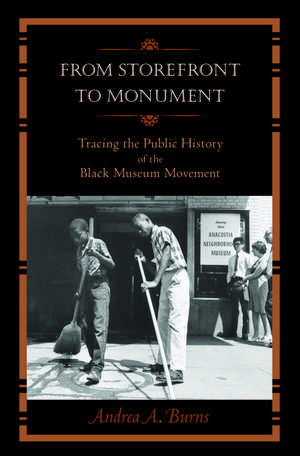From Storefront to Monument: Tracing the Public History of the Black Museum Movement: Public History in Historical Perspective
Autor Andrea A. Burnsen Limba Engleză Paperback – 3 oct 2013
Winner of the 2015 National Council on Public History Book Award
Today well over two hundred museums focusing on African American history and culture can be found throughout the United States and Canada. Many of these institutions trace their roots to the 1960s and 1970s, when the struggle for racial equality inspired a movement within the black community to make the history and culture of African America more "public."
This book tells the story of four of these groundbreaking museums: the DuSable Museum of African American History in Chicago (founded in 1961); the International Afro-American Museum in Detroit (1965); the Anacostia Neighborhood Museum in Washington, D.C. (1967); and the African American Museum of Philadelphia (1976). Andrea A. Burns shows how the founders of these institutions, many of whom had ties to the Black Power movement, sought to provide African Americans with a meaningful alternative to the misrepresentation or utter neglect of black history found in standard textbooks and most public history sites. Through the recovery and interpretation of artifacts, documents, and stories drawn from African American experience, they encouraged the embrace of a distinctly black identity and promoted new methods of interaction between the museum and the local community.
Over time, the black museum movement induced mainstream institutions to integrate African American history and culture into their own exhibits and educational programs. This often controversial process has culminated in the creation of a National Museum of African American History and Culture, now scheduled to open in the nation's capital in 2015.
Today well over two hundred museums focusing on African American history and culture can be found throughout the United States and Canada. Many of these institutions trace their roots to the 1960s and 1970s, when the struggle for racial equality inspired a movement within the black community to make the history and culture of African America more "public."
This book tells the story of four of these groundbreaking museums: the DuSable Museum of African American History in Chicago (founded in 1961); the International Afro-American Museum in Detroit (1965); the Anacostia Neighborhood Museum in Washington, D.C. (1967); and the African American Museum of Philadelphia (1976). Andrea A. Burns shows how the founders of these institutions, many of whom had ties to the Black Power movement, sought to provide African Americans with a meaningful alternative to the misrepresentation or utter neglect of black history found in standard textbooks and most public history sites. Through the recovery and interpretation of artifacts, documents, and stories drawn from African American experience, they encouraged the embrace of a distinctly black identity and promoted new methods of interaction between the museum and the local community.
Over time, the black museum movement induced mainstream institutions to integrate African American history and culture into their own exhibits and educational programs. This often controversial process has culminated in the creation of a National Museum of African American History and Culture, now scheduled to open in the nation's capital in 2015.
Din seria Public History in Historical Perspective
-
 Preț: 212.30 lei
Preț: 212.30 lei -
 Preț: 222.20 lei
Preț: 222.20 lei -
 Preț: 181.18 lei
Preț: 181.18 lei -
 Preț: 257.54 lei
Preț: 257.54 lei -
 Preț: 235.15 lei
Preț: 235.15 lei -
 Preț: 263.47 lei
Preț: 263.47 lei -
 Preț: 263.29 lei
Preț: 263.29 lei -
 Preț: 295.59 lei
Preț: 295.59 lei -
 Preț: 272.32 lei
Preț: 272.32 lei -
 Preț: 258.54 lei
Preț: 258.54 lei - 15%
 Preț: 563.20 lei
Preț: 563.20 lei -
 Preț: 274.83 lei
Preț: 274.83 lei -
 Preț: 291.90 lei
Preț: 291.90 lei -
 Preț: 262.40 lei
Preț: 262.40 lei -
 Preț: 199.63 lei
Preț: 199.63 lei -
 Preț: 231.98 lei
Preț: 231.98 lei -
 Preț: 225.44 lei
Preț: 225.44 lei -
 Preț: 225.10 lei
Preț: 225.10 lei -
 Preț: 219.44 lei
Preț: 219.44 lei - 15%
 Preț: 562.36 lei
Preț: 562.36 lei -
 Preț: 200.82 lei
Preț: 200.82 lei - 15%
 Preț: 563.03 lei
Preț: 563.03 lei -
 Preț: 215.75 lei
Preț: 215.75 lei -
 Preț: 215.42 lei
Preț: 215.42 lei -
 Preț: 266.77 lei
Preț: 266.77 lei -
 Preț: 222.99 lei
Preț: 222.99 lei
Preț: 213.24 lei
Nou
Puncte Express: 320
Preț estimativ în valută:
40.80€ • 42.61$ • 33.69£
40.80€ • 42.61$ • 33.69£
Carte disponibilă
Livrare economică 25 martie-08 aprilie
Preluare comenzi: 021 569.72.76
Specificații
ISBN-13: 9781625340351
ISBN-10: 1625340354
Pagini: 264
Ilustrații: 10 b&w illus.
Dimensiuni: 152 x 229 x 20 mm
Greutate: 0.41 kg
Ediția:First Edition
Editura: University of Massachusetts Press
Colecția University of Massachusetts Press
Seria Public History in Historical Perspective
ISBN-10: 1625340354
Pagini: 264
Ilustrații: 10 b&w illus.
Dimensiuni: 152 x 229 x 20 mm
Greutate: 0.41 kg
Ediția:First Edition
Editura: University of Massachusetts Press
Colecția University of Massachusetts Press
Seria Public History in Historical Perspective
Notă biografică
Andrea A. Burns is assistant professor of history at Appalachian State University.
Recenzii
"Clearly written and concisely argued, From Storefront to Monument will be of great interest to scholars in the field of museum studies. It also deserves wide readership in the broader field of African American studies, where there has been no comparable work that offers an overarching history of the black museum movement as an important political movement."—Renee Romano, coeditor of The Civil Rights Movement in American Memory
"Clearly written and concisely argued, From Storefront to Monument will be of great interest to scholars in the field of museum studies. It also deserves wide readership in the broader field of African American studies, where there has been no comparable work that offers an overarching history of the black museum movement as an important political movement."—Renee Romano, coeditor of The Civil Rights Movement in American Memory
"A work of impressive and seminal scholarship."—Midwest Book Review
"The book is very well written, and those outside academia will enjoy it. It will also be a remarkable addition to any collection in contemporary US history, Museum studies, and African American history. Highly recommended."—Choice
"Andrea A. Burns's well-written and compelling book focuses on the creation of four African American neighborhood museums by tracing their beginnings in the 1960s, influenced by the Black Power Movement, to today. . . . The book contributes to those interested in American history, museum studies, African American studies, public history and as the author notes, Black public history. It is an engrossing story about these important neighborhood institutions."—Information Culture
"Let's face it: Andrea Burns is right. Her book, From Storefront to Monument, rightfully points out the disenfranchisement of African Americans in museums in the past, and describes the efforts to bring more African Americans to the table."—crg@cgp
"Timely and important . . . Burns is smartly attentive to the power of geography and the class identifications and conflicts embedded in these institutions. . . . From Storefront to Monument makes significant contributions to the larger historical discipline and should be read widely across the field."—Journal of American History
"The picture provided by Burns of the life history of these African American museums is insightful and well researched. . . . Burns reminds us there is much to learn from the path followed by the museums and their founders."—American Historical Review
"[A] blow by blow history of the founding of the earliest serious museums of African American Art and Culture."—Journal of American Culture
"This book examines museums as living ecosystems, makes labor visible, and asks how public history institutions write the master narrative of the nation. . . . [It] yields rich insight about the work of public history--and should be a reminder to future scholars of the necessity to understand the complex workings of its institutions before making grand claims about its products."—American Quarterly
"Clearly written and concisely argued, From Storefront to Monument will be of great interest to scholars in the field of museum studies. It also deserves wide readership in the broader field of African American studies, where there has been no comparable work that offers an overarching history of the black museum movement as an important political movement."—Renee Romano, coeditor of The Civil Rights Movement in American Memory
"A work of impressive and seminal scholarship."—Midwest Book Review
"The book is very well written, and those outside academia will enjoy it. It will also be a remarkable addition to any collection in contemporary US history, Museum studies, and African American history. Highly recommended."—Choice
"Andrea A. Burns's well-written and compelling book focuses on the creation of four African American neighborhood museums by tracing their beginnings in the 1960s, influenced by the Black Power Movement, to today. . . . The book contributes to those interested in American history, museum studies, African American studies, public history and as the author notes, Black public history. It is an engrossing story about these important neighborhood institutions."—Information Culture
"Let's face it: Andrea Burns is right. Her book, From Storefront to Monument, rightfully points out the disenfranchisement of African Americans in museums in the past, and describes the efforts to bring more African Americans to the table."—crg@cgp
"Timely and important . . . Burns is smartly attentive to the power of geography and the class identifications and conflicts embedded in these institutions. . . . From Storefront to Monument makes significant contributions to the larger historical discipline and should be read widely across the field."—Journal of American History
"The picture provided by Burns of the life history of these African American museums is insightful and well researched. . . . Burns reminds us there is much to learn from the path followed by the museums and their founders."—American Historical Review
"[A] blow by blow history of the founding of the earliest serious museums of African American Art and Culture."—Journal of American Culture
"This book examines museums as living ecosystems, makes labor visible, and asks how public history institutions write the master narrative of the nation. . . . [It] yields rich insight about the work of public history--and should be a reminder to future scholars of the necessity to understand the complex workings of its institutions before making grand claims about its products."—American Quarterly














